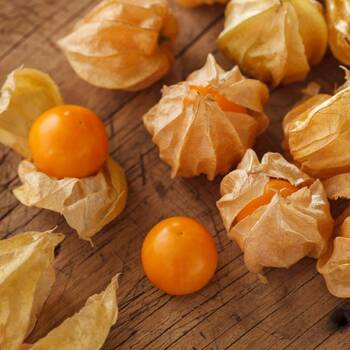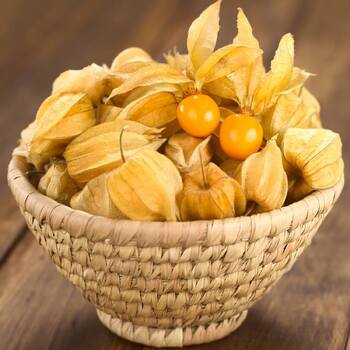
How to Grow Cape Gooseberry Seeds
Grow Guide #2466
Family: Solanaceae
Binomial name: Physalis peruviana
Life Cycle: Perennial (usually grown as an annual)
This 'How to Grow' guide details everything a home gardener needs to know to plant, grow and care for Cape Gooseberry (Physalis peruviana).
When to Sow Cape Gooseberry Seeds
Cape Gooseberry is a warm season crop. Use the table below to identify the best time of year to sow Cape gooseberry seeds in your climate.
| JAN | FEB | MAR | APR | MAY | JUN | JUL | AUG | SEP | OCT | NOV | DEC | |
|---|---|---|---|---|---|---|---|---|---|---|---|---|
| Cool | ||||||||||||
| Temperate | ||||||||||||
| Sub-Tropical | ||||||||||||
| Tropical | ||||||||||||
| Arid |
Preparation
Cape Gooseberry plants are best grown in full sun or part shade. Choose a location that will receive at least 3 hours of full sun each day.
Cape Gooseberry plants need a well drained soil enriched with plenty of organic matter. Prepare soil by weeding it thoroughly, digging it over to loosen it and adding aged animal manure or compost. Keep the area free of weeds until planting. Learn more about preparing soil for planting here.
Cape Gooseberry plants can be grown in containers. If possible choose a variety that’s recommended for container growing. Use a good quality potting mix and make sure your container is large enough for mature plants; a minimum of 75 litres is recommended for Cape gooseberry. During the growing season, keep in mind that container grown plants may need additional fertiliser to encourage healthy growth.
How to Sow Cape Gooseberry Seeds
Cape Gooseberry seeds do not require any treatment (eg soaking, stratification) before sowing.
Cape Gooseberry seeds grow best when they are raised in trays or other containers and transplanted to the garden once established.
- Fill trays, punnets or jiffy pots with a good quality seed-raising mix, or use soil starter pellets.
- Sow seeds 4mm deep.
- Keep soil moist but never wet or dry.
- Seeds should germinate in around 14-42 days at a soil temperature of 21-29°C.
- Transplant seedlings to the garden once they have their first true leaves and are large enough to handle (usually 5-10cm tall).
- Plant out, spacing plants 30-100cm apart.
Cape Gooseberry is a tender crop that’s sensitive to frost. Do not transplant seedlings or sow seeds outside until all danger of frost has passed.
Tip: Seeds of this variety can be slow to germinate. Take note of the expected germination time, be patient and follow the recommended depth and temperature guidelines closely for the best chance of success.
Optional: In cool climates Cape gooseberry seeds can be sown indoors 6 weeks before the last expected frost. Grow them in a warm position with plenty of natural light.
How to Grow Cape Gooseberry
Cape Gooseberry plants need regular watering during the growing season. Do not let soil dry out; keep soil evenly moist but not waterlogged. Water deeply in the early morning or late afternoon. Avoid watering the leaves of plants to avoid fungal diseases. Learn more about watering here.
If soil was well prepared no extra fertiliser should be necessary. In poor soil or to give your plants an extra boost, application of a balanced fertiliser or one formulated for fruit and vegetables can be beneficial:
- Apply slow release fertiliser at the recommended rate when transplanting or when seedlings are 5-10cm tall.
- Apply liquid fertiliser at the recommended rate and frequency while plants are fruiting or flowering.
Plants may need to be staked for support. Use a sturdy stake and tie stems gently to it using twine or plant ties. Make sure you have the stake in place when you sow seed or transplant seedlings to avoid disturbing the plant’s roots later.
Tip - Cape Gooseberry plants can be grown as annuals or short-lived perennials. In tropical and subtropical climates plants will grow and fruit year-round. In temperate and cool climates plants are usually grown as warm-season annuals. To grow plants as perennials in cool climates, grow them in a sheltered position and protect them from frost OR overwinter plants by potting them up and placing them in a sheltered position, pruning plants hard in early winter and removing any damaged foliage in spring.
How to Harvest Cape Gooseberry
Cape Gooseberry should be ready to harvest in approximately 140 days.
Cape gooseberries are ready to harvest when the husk lightens in colour and becomes papery or when the fruit falls to the ground. Harvest fruit by cutting with snips/secateurs or by twisting to separate it from the stem. Harvest regularly to encourage more fruit. For short term storage, harvested fruit can be kept in its husk in a paper bag at room temperature or in the fridge. For long term storage fruit can be frozen or canned.
Common Problems when Growing Cape Gooseberry
Like all plants, Cape gooseberry is susceptible to some pests, diseases and other problems. Below is a list of the most common problems gardeners encounter when growing Cape gooseberry plants:
 Aphids are small (2-4mm long) sap-sucking insects that congregate on the new shoots or the undersides of leaves. They can cause leaves to wilt or become discoloured, and also excrete honeydew which can attract ants and other insect pests. To manage aphids, remove them by spraying with a garden hose, apply a soap or alcohol spray, or encourage predatory insects to your garden. Read more about aphids here.
Aphids are small (2-4mm long) sap-sucking insects that congregate on the new shoots or the undersides of leaves. They can cause leaves to wilt or become discoloured, and also excrete honeydew which can attract ants and other insect pests. To manage aphids, remove them by spraying with a garden hose, apply a soap or alcohol spray, or encourage predatory insects to your garden. Read more about aphids here. Queensland Fruit Fly (Bactrocera tryoni) that lays its eggs in fruit, causing it to rot from the inside. Fruit will fall prematurely and larvae can be seen if affected fruit is cut open. Practice good garden hygiene by disposing of fallen fruit, protect fruit with insect exclusion netting and install traps to monitor fruit fly populations. Read more about Queensland fruit fly here.
Queensland Fruit Fly (Bactrocera tryoni) that lays its eggs in fruit, causing it to rot from the inside. Fruit will fall prematurely and larvae can be seen if affected fruit is cut open. Practice good garden hygiene by disposing of fallen fruit, protect fruit with insect exclusion netting and install traps to monitor fruit fly populations. Read more about Queensland fruit fly here. Blossom end rot is a nutrient deficiency caused by a lack of calcium uptake, often due to inconsistent watering. Fruit will discolour from the bottom end upwards, with the affected area growing darker and harder. Dispose of affected fruit, water regularly and evenly, and correct soil pH and nutrients if required. Read more about blossom end rot here.
Blossom end rot is a nutrient deficiency caused by a lack of calcium uptake, often due to inconsistent watering. Fruit will discolour from the bottom end upwards, with the affected area growing darker and harder. Dispose of affected fruit, water regularly and evenly, and correct soil pH and nutrients if required. Read more about blossom end rot here..jpg) Powdery mildew is caused by fungal spores reproducing on the leaves of plants. First showing as white spots on leaves, affected areas can spread quickly to cover the entire leaf surface. While rarely fatal, powdery mildew can reduce yields. Water plants at soil level (not on leaves) to prevent spreading spores, allow good air flow between plants, remove affected leaves and if necessary spray with an appropriate fungicide or homemade spray. Read more here about powdery mildew here.
Powdery mildew is caused by fungal spores reproducing on the leaves of plants. First showing as white spots on leaves, affected areas can spread quickly to cover the entire leaf surface. While rarely fatal, powdery mildew can reduce yields. Water plants at soil level (not on leaves) to prevent spreading spores, allow good air flow between plants, remove affected leaves and if necessary spray with an appropriate fungicide or homemade spray. Read more here about powdery mildew here. Root rot is a disease caused by soil-borne fungi found in wet soil. Plants may be slow to establish, have yellowing or wilted foliage and have soft, brown tissue around the base of the stem and roots. Root rot is often fatal; remove and dispose of affected plants. Reducing soil moisture, adding organic matter to the soil and making sure mulch doesn't touch the stems of plants may help avoid root rot.
Root rot is a disease caused by soil-borne fungi found in wet soil. Plants may be slow to establish, have yellowing or wilted foliage and have soft, brown tissue around the base of the stem and roots. Root rot is often fatal; remove and dispose of affected plants. Reducing soil moisture, adding organic matter to the soil and making sure mulch doesn't touch the stems of plants may help avoid root rot. Slugs and snails are molluscs that feed on tender leaves and shoots, mostly at night, leaving slimy trails behind them. Control them by removing their hiding places, keeping free range poultry, collecting them by torchlight or by placing traps. Read more about slugs and snails here.
Slugs and snails are molluscs that feed on tender leaves and shoots, mostly at night, leaving slimy trails behind them. Control them by removing their hiding places, keeping free range poultry, collecting them by torchlight or by placing traps. Read more about slugs and snails here.


.png)




